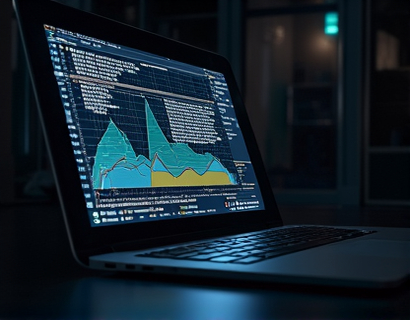Unlocking the Potential of Digital Asset Management: Advanced Smart-Contract Technology for UCASH and U Assets
The landscape of digital asset management is rapidly evolving, driven by advancements in blockchain technology and smart contracts. This article delves into the transformative power of leveraging advanced smart-contract technology to create and manage tokens securely and efficiently, specifically pegged to leading cryptocurrencies and digital assets like UCASH and U assets. By understanding the intricacies of this technology, financial ecosystems can significantly enhance their security and performance.
Understanding Tokenization
Tokenization refers to the process of converting rights to an asset into a digital token on a blockchain. These tokens can represent a wide range of assets, from real estate and commodities to cryptocurrencies and utility tokens. The key advantage of tokenization lies in its ability to fractionalize assets, making them more accessible to a broader audience. In the context of UCASH and U assets, tokenization allows for the creation of tokens that mirror the value of these digital assets, providing investors with a new way to participate in the market.
Smart Contracts: The Backbone of Token Management
Smart contracts are self-executing contracts with the terms of the agreement directly written into code. They run on blockchain networks, ensuring transparency, security, and automation. In the realm of digital asset management, smart contracts play a crucial role in creating and managing tokens. For UCASH and U assets, advanced smart-contract technology ensures that tokens are issued, traded, and managed with the highest level of security and efficiency.
Key Features of Advanced Smart-Contract Technology
1. Security: Advanced smart contracts employ robust cryptographic techniques to protect against tampering and fraud. This is particularly important for tokens pegged to UCASH and U assets, where the integrity of the token's value is paramount.
2. Automation: Smart contracts automate the execution of contractual obligations, reducing the need for intermediaries and minimizing human error. This automation ensures that token issuance, distribution, and redemption processes are seamless and reliable.
3. Transparency: All transactions and contract executions are recorded on the blockchain, providing a transparent and auditable trail. This transparency builds trust among users and stakeholders, enhancing the overall credibility of the tokenized assets.
4. Interoperability: Advanced smart contracts can interact with other blockchain networks and protocols, enabling a more interconnected and efficient financial ecosystem. This interoperability is crucial for tokens pegged to multiple assets, ensuring smooth operations across different platforms.
Creating Tokens Pegged to UCASH and U Assets
The process of creating tokens pegged to UCASH and U assets involves several steps, each facilitated by advanced smart-contract technology.
Step 1: Define the Token Parameters
The first step is to define the parameters of the token, including its name, symbol, total supply, and the asset it is pegged to (UCASH or U assets). These parameters are encoded into the smart contract, ensuring that the token's behavior aligns with the underlying asset's value.
Step 2: Implement Peg Mechanism
The peg mechanism is a critical component that maintains the token's value in line with the UCASH or U assets. This is achieved through an algorithmic stablecoin approach or a reserve-backed model. The smart contract automatically adjusts the supply of tokens based on the value of the pegged asset, ensuring stability.
For a reserve-backed model, the smart contract maintains a reserve of UCASH or U assets, ensuring that each token represents a proportional amount of the underlying asset. This reserve is securely stored and managed within the smart contract.
Step 3: Ensure Compliance and Auditing
Compliance with regulatory requirements is essential for the legitimacy and sustainability of tokenized assets. Advanced smart contracts can incorporate compliance checks and auditing mechanisms to ensure adherence to legal standards. This includes verifying the identity of users and monitoring transactions for any suspicious activity.
Step 4: Deployment and Maintenance
Once the smart contract is developed and tested, it is deployed on a blockchain network. Ongoing maintenance is crucial to address any issues, update the contract as needed, and ensure the continued stability and security of the token.
Benefits of Advanced Smart-Contract Technology
1. Enhanced Security: The immutable nature of blockchain and the robust cryptographic techniques used in smart contracts significantly reduce the risk of fraud and unauthorized access.
2. Increased Efficiency: Automated processes reduce the need for intermediaries, speeding up transactions and lowering costs. This efficiency is particularly beneficial for global investors dealing with UCASH and U assets.
3. Greater Accessibility: Tokenization makes it easier for a wider range of investors to participate in the market. Smaller investments can be made with lower entry points, democratizing access to high-value assets.
4. Improved Liquidity: Smart contracts facilitate seamless trading of tokens, enhancing liquidity and making it easier for investors to buy and sell assets quickly and at fair prices.
Case Studies and Real-World Applications
Several projects have successfully implemented advanced smart-contract technology for tokenization, serving as valuable case studies for the potential of UCASH and U assets management.
Project A: Stablecoin Tokenization
Project A launched a stablecoin token pegged to UCASH, utilizing a reserve-backed smart contract. The project ensured transparency by regularly publishing reserve balances and conducting independent audits. The token achieved high liquidity and stability, attracting a diverse investor base.
Project B: Utility Token for U Assets
Project B created utility tokens for a platform offering various services based on U assets. The smart contract automated the distribution of tokens based on user engagement and contributions, fostering a vibrant community and sustainable ecosystem.
Challenges and Considerations
While the potential of advanced smart-contract technology is vast, there are challenges and considerations to address:
Regulatory Compliance
Navigating the regulatory landscape is crucial. Different jurisdictions have varying rules regarding digital assets and smart contracts. Compliance with these regulations is essential to avoid legal issues and ensure the project's legitimacy.
Technical Complexity
Developing and deploying advanced smart contracts requires specialized knowledge and expertise. Collaborating with experienced blockchain developers and conducting thorough testing are essential to mitigate risks.
Market Volatility
While pegged tokens aim to maintain stability, market volatility can still impact the value of underlying assets. Implementing robust risk management strategies and maintaining a sufficient reserve can help mitigate these effects.
Future Prospects
The future of digital asset management through advanced smart-contract technology looks promising. As blockchain technology continues to mature, we can expect:
1. Increased Adoption: More financial institutions and individuals will adopt tokenized assets, driving growth and innovation.
2. Enhanced Features: Smart contracts will become more sophisticated, incorporating features like decentralized governance and automated rebalancing.
3. Broader Asset Integration: Tokenization will extend to a wider range of assets, including real estate, commodities, and even traditional financial instruments.
Embracing these advancements can significantly enhance the security, efficiency, and accessibility of financial ecosystems, making them more resilient and inclusive.










































